Italian cheesecake is a beautiful dessert that’s both creamy and airy in texture, and bright and citrusy in flavor. Our version is topped with a lemon blueberry sauce that perfectly complements the orange in the cake. This ricotta cheesecake is the perfect dessert for holidays, birthdays, or anytime you want a little bit of decadence.
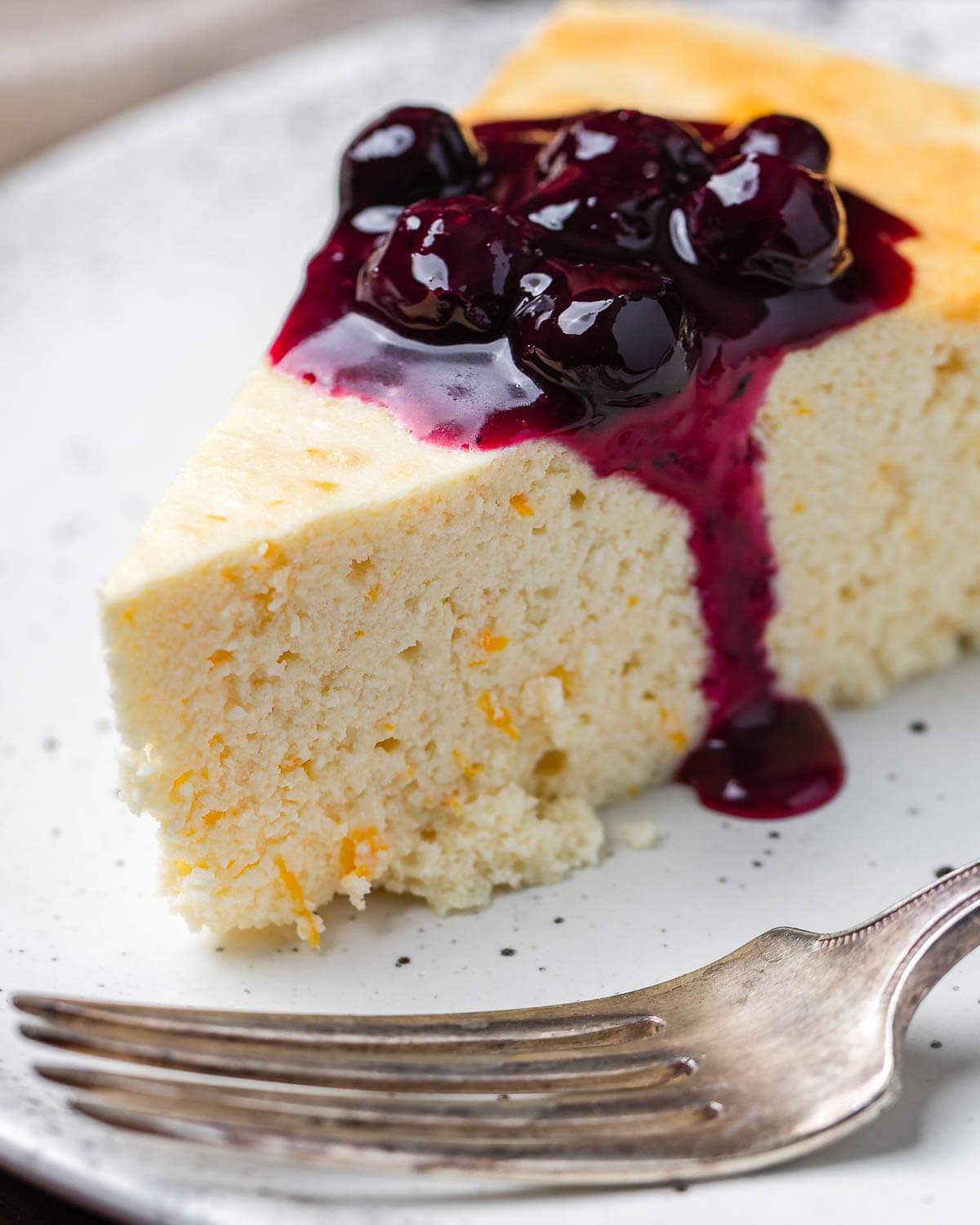
This post may contain affiliate links. Our disclosure policy.
Italian cheesecake has always been a favorite of mine.
Thanks to the ricotta, its texture is lighter than a New York-style cheesecake, and the orange zest takes the flavor over the top.
The flavor of this particular cheesecake is quite similar to the Easter treat, pastiera Napoletana, just without the crust, citron, and grano cotto.
Italian cheesecake with blueberry sauce is a welcome addition to any dessert table and goes especially well with an espresso, or an espresso martini.
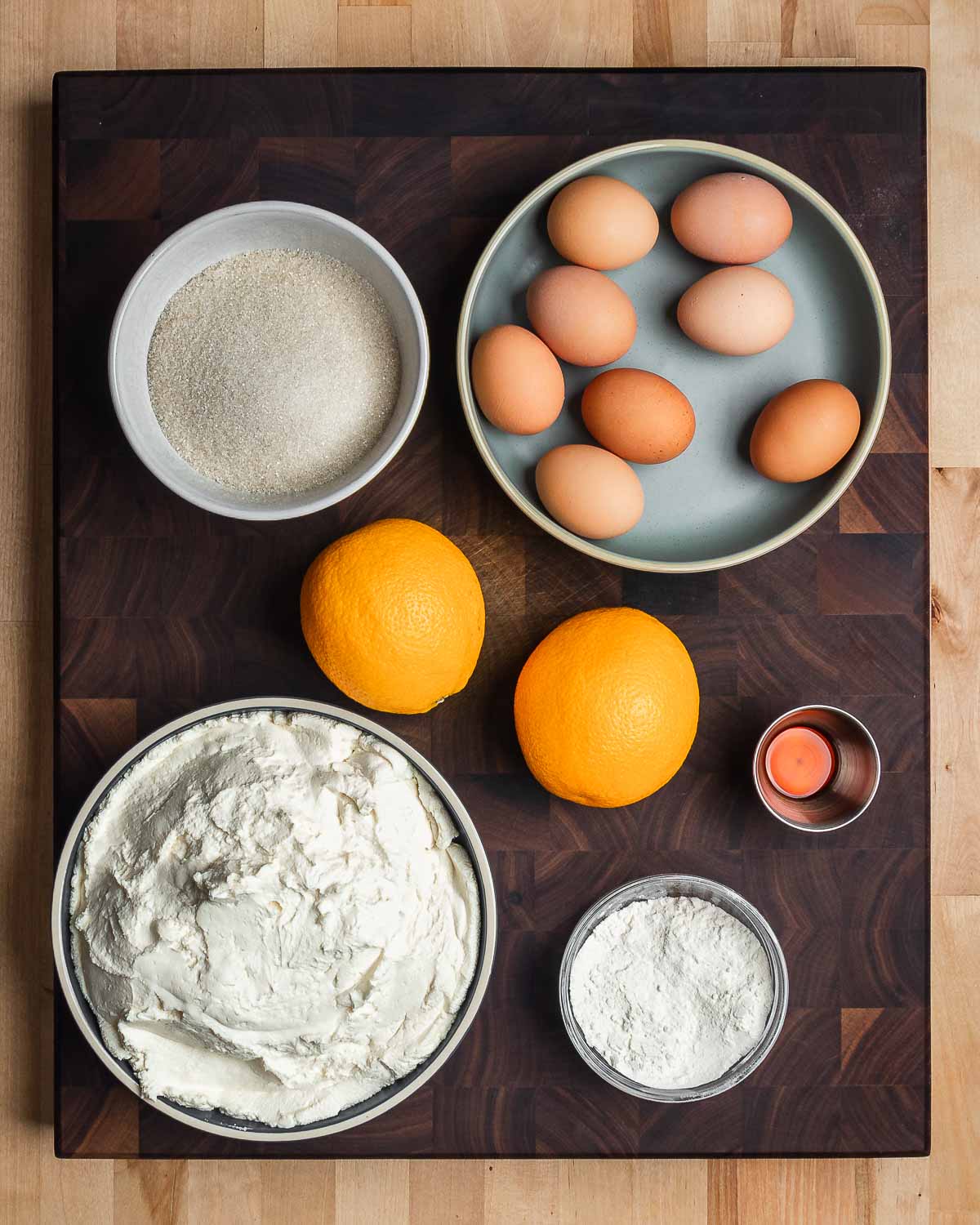
Want To Save This Recipe?
How to make it
Each number corresponds to the numbered written steps below.
- The night before you plan to make your cheesecake, begin to drain 2 pounds of whole-milk ricotta through a cheesecloth or fine mesh sieve placed over a small pot to collect the moisture. To help with the draining process, weigh the ricotta down by placing a plate or two on top.
- The next day, wring out whatever moisture is left in the ricotta by twisting the cheesecloth as shown. Note: Depending on the brand of ricotta you might be surprised how much water will collect in the pot!
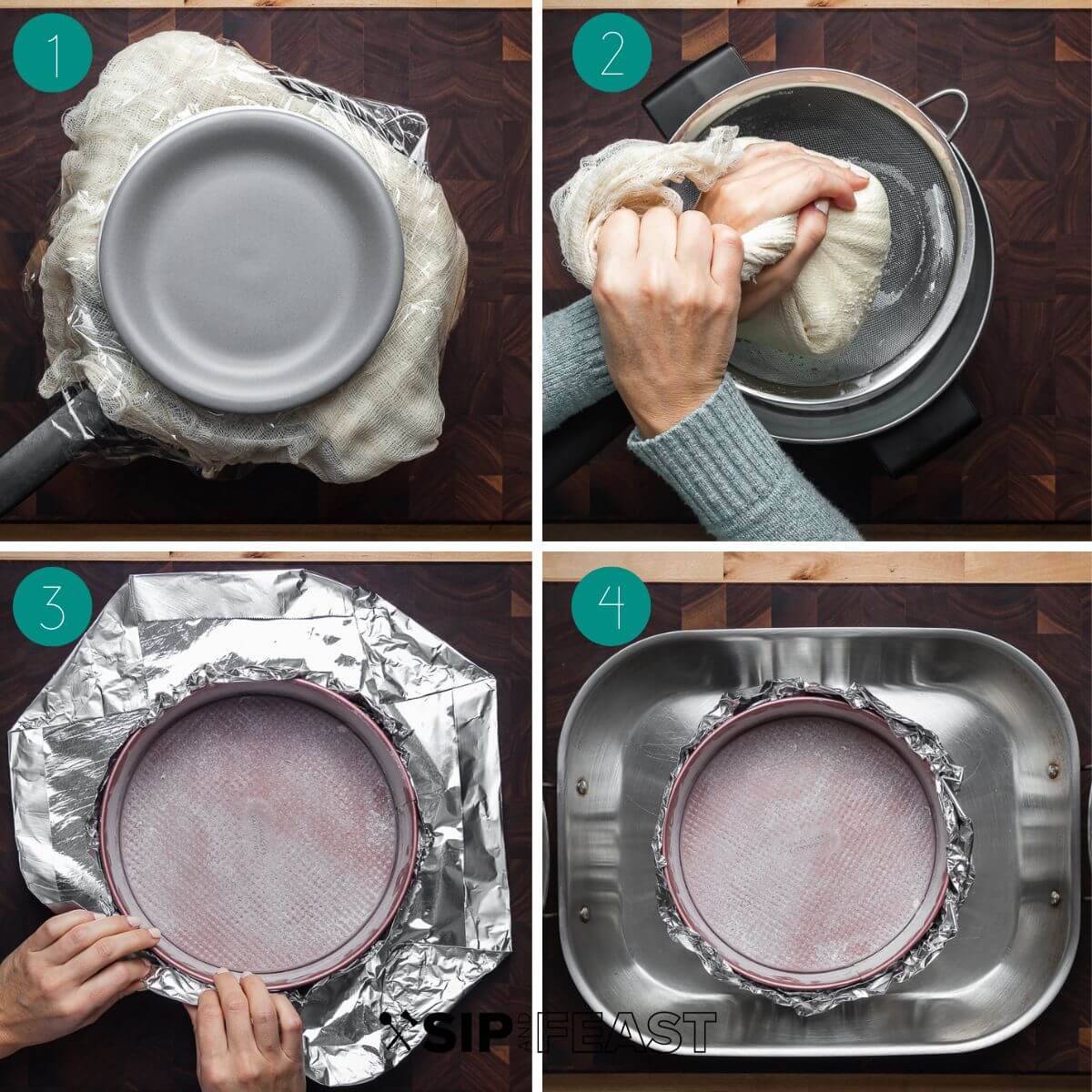
- Preheat the oven to 400f. Grease and lightly flour a 9-inch spring form pan and wrap the pan in two layers of foil. This will help prevent water from seeping into the pan later when you make the water bath.
- Place the springform pan into a roasting pan large enough to allow for a water bath halfway up the sides of the springform pan. Set aside.
- Separate 5 room temperature eggs taking care to not get any of the yolk mixed in with the white. In a large bowl or the bowl of a stand mixer fitted with a paddle attachment, beat the drained ricotta until smooth (about 15 seconds) and gradually add 2/3 cup of sugar and the egg yolks, whisking after each addition (about 1 minute).
- Add 1/4 cup of sifted flour, the zest of 2 large oranges, and 1 teaspoon of vanilla extract and whisk until incorporated (about 30 seconds).
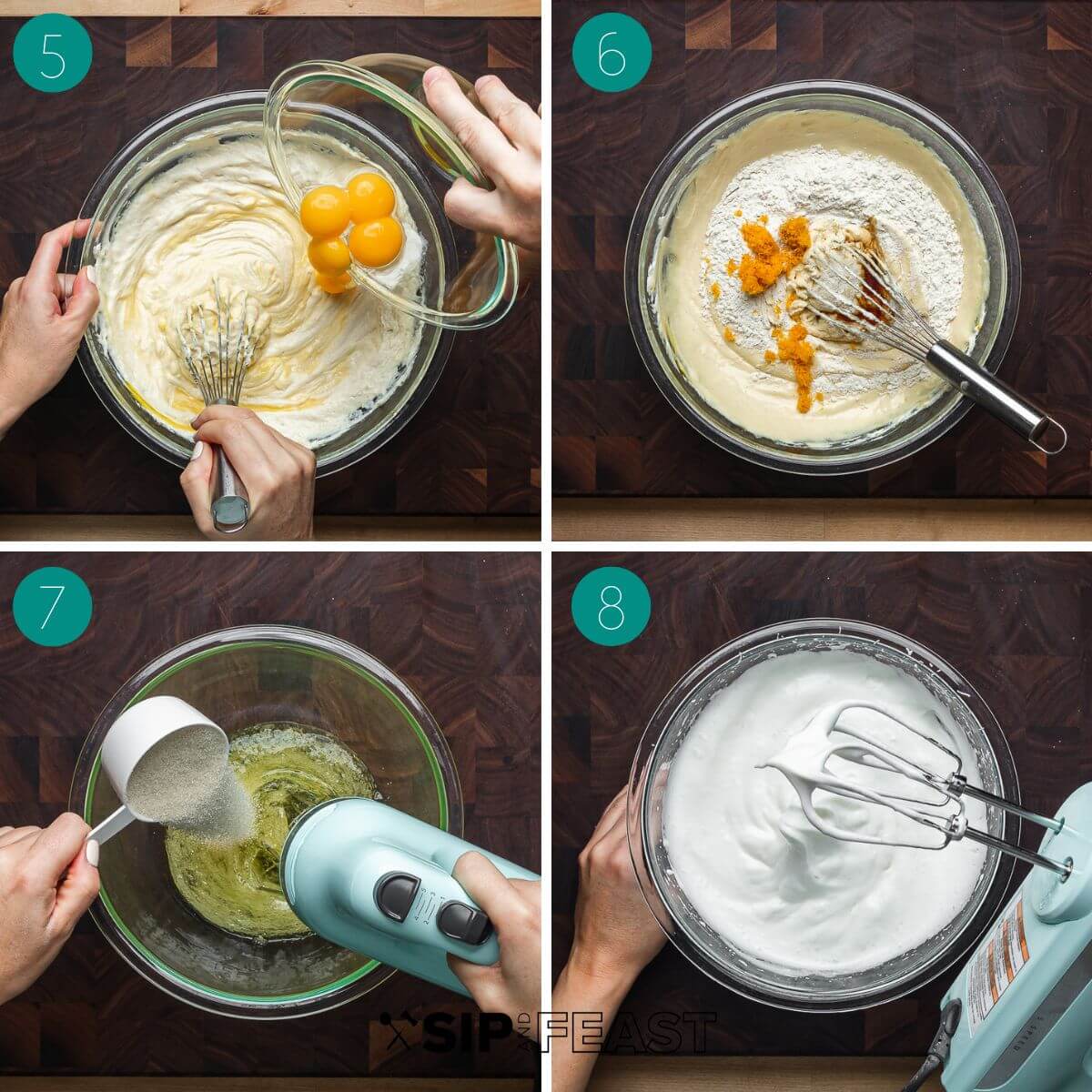
- In a separate clean bowl that is free of any grease, or the bowl of a stand mixer fitted with a whisk attachment, begin to beat the 5 egg whites on medium speed for 30 seconds, then add the remaining 1/3 cup of sugar.
- Once the sugar is added, beat on high speed until medium-soft peaks are formed (medium-soft peaks are shown in pic 8 above).
- Using a spatula, fold the egg whites into the ricotta mixture.
- Continue to fold until incorporated taking care to not overmix.
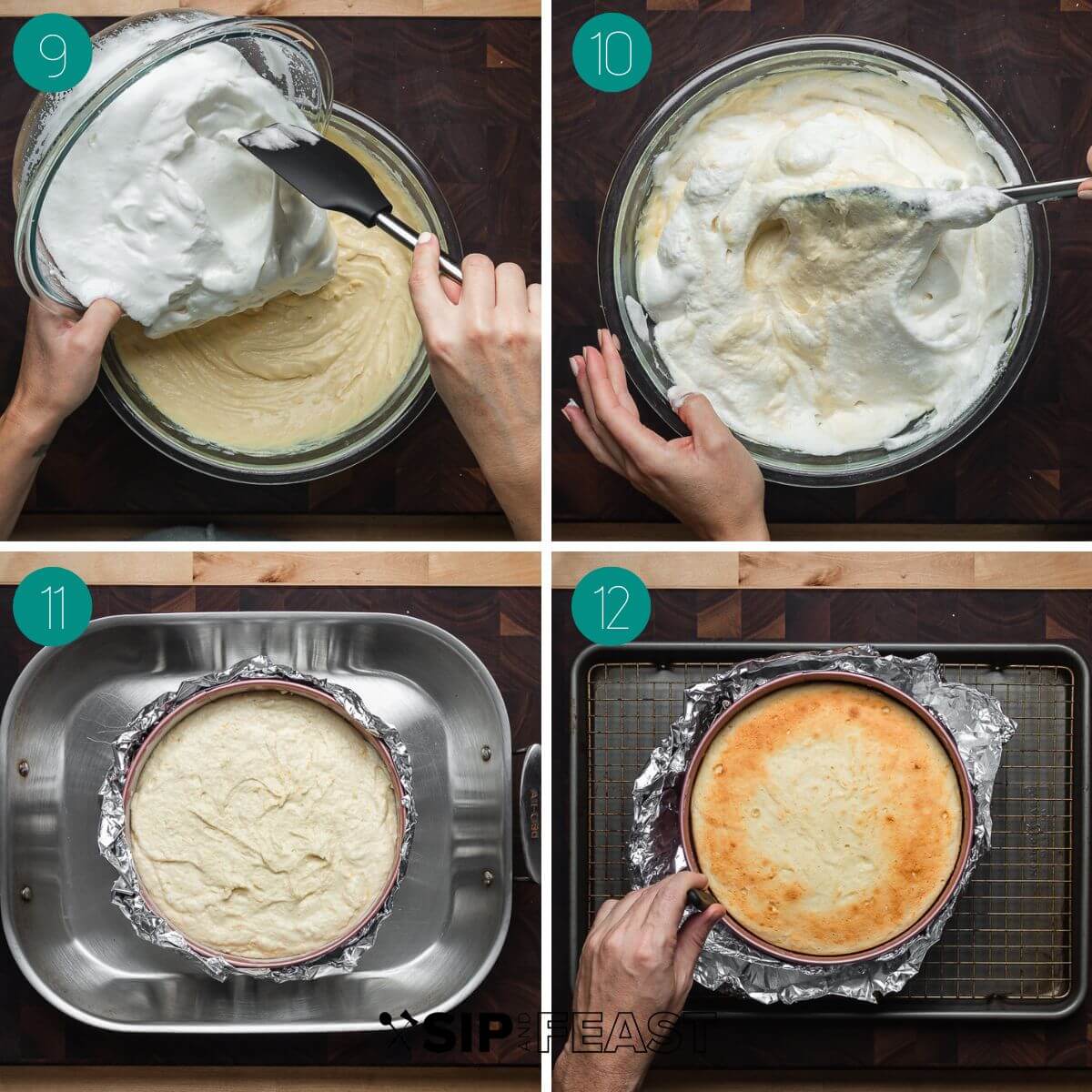
- Add the batter to the prepared springform pan and create a water bath (bain-marie) by adding enough hot water to cover the bottom 1/2 of the springform pan.
- Bake the cheesecake for 10 minutes, then reduce the heat to 325f and bake for 45 minutes until golden on top and slightly jiggly in the center. Turn off the heat in the oven and allow the cheesecake to cool in the oven for 30 minutes with the door slightly ajar. That means open the oven by only 1-2 inches. Remove from the oven and run a thin blade knife around the edge of the cake to ensure it’s not sticking and allow the cake to come to room temperature. Then, cover and move the cheesecake to the refrigerator for a minimum of 6 hours. Once chilled, remove the cake from the springform pan. Slice and serve with the blueberry sauce on the side and enjoy!
How to make blueberry lemon sauce
- Place 10 ounces of frozen blueberries, 1/2 cup of water, 1/2 cup of sugar, and 1 teaspoon of vanilla extract in a small saucepan and cook over medium heat until the mixture comes to a boil. Mix 1 1/2 tablespoons of cornstarch with 1 1/2 tablespoons of water to create a slurry and add to the blueberry mixture. Allow the mixture to come to a rolling boil, then reduce the heat to a simmer.
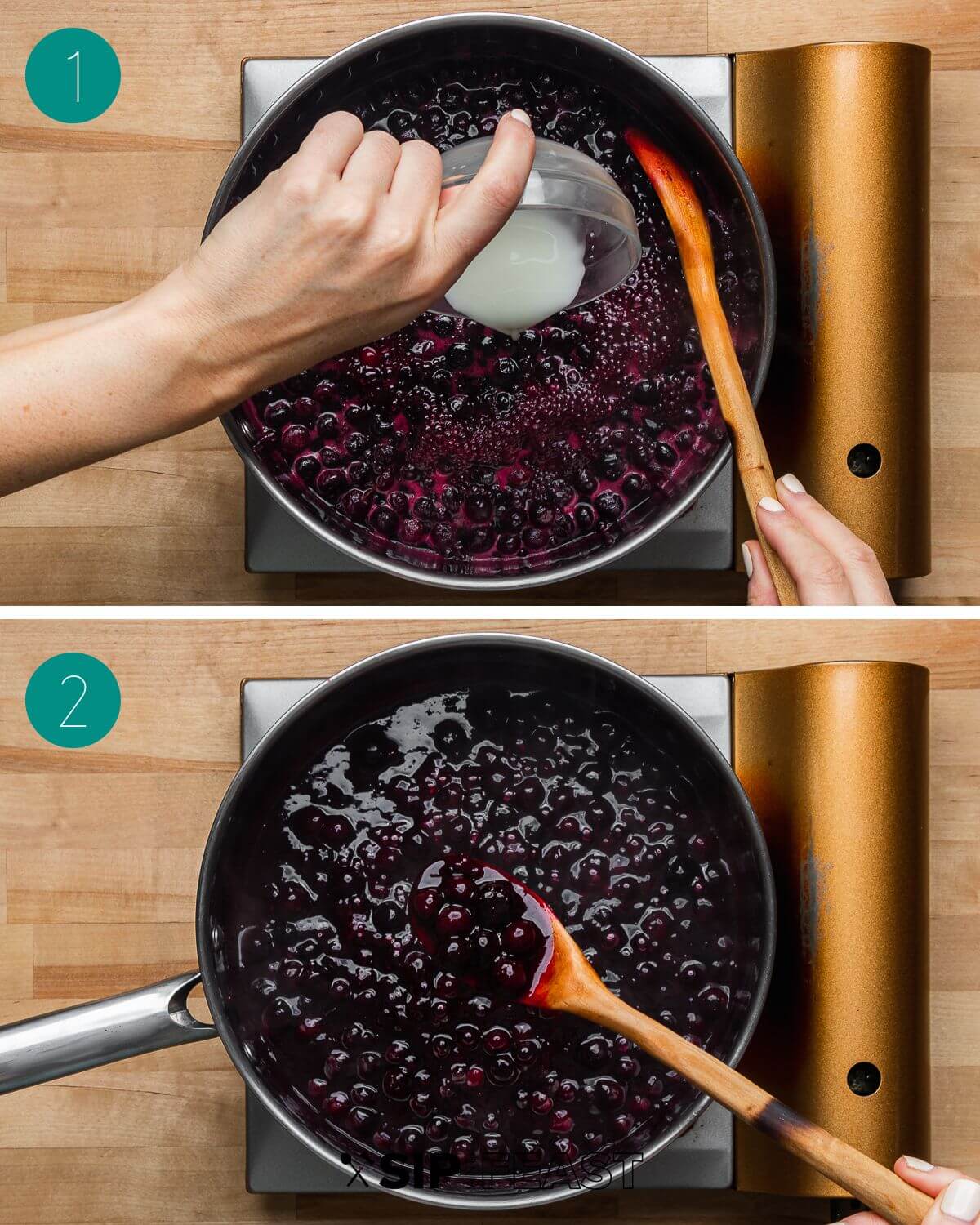
- Allow to simmer for 1-2 minutes or until the mixture reaches your desired consistency. Remove from the heat and gently stir in the zest of a large lemon taking care to not crush the blueberries. Refrigerate until you’re ready to serve drizzled over a slice of ricotta cheesecake.
Top tips
- Be patient. Italian cheesecake, or any cheesecake, is not something that is made on a whim. It requires planning and preparation but is well worth it in the end.
- The ricotta. The drier the ricotta, the better. I recommend buying a brand that is on the drier side, like Galbani. While Polly-O is delicious in its own right, it has higher moisture and is better more for baked ziti than desserts in our opinion. Regardless of the brand you use, draining through a cheesecloth for at least several hours (I recommend overnight) is essential otherwise you may wind up with cheesecake that is runny or doesn’t set properly.
- Egg whites. When beating egg whites, it’s imperative to not allow any of the yolk (the fat), or any other grease to come in contact with the whites otherwise they’ll never stand up no matter how long you beat them.
- Be gentle when cooking. Using a water bath, also known as a bain-marie, helps to gently cook the cheesecake and helps to prevent sudden temperature changes that can lead to cracking or deflating. We strongly recommend following our process for cooking, beginning with the bain-marie, reducing the temperature after 10 minutes of cooking, and allowing the cake to cool in the oven for 30 minutes with the door cracked, etc. Also, avoid making sudden hard movements near and around the oven while the cheesecake is there.
- More on the bain-marie. I found it helpful to first place the roasting pan/cheesecake combo on the rack in the oven and pull the rack out enough to allow us to fill the roasting pan from a kettle of hot water. That way I wasn’t transporting the entire pan filled with hot water to the oven.
- Serve chilled. Italian cheesecake will be best after a minimum of 6 hours in the fridge. It’s best served chilled, and while it’s delicious with nothing on it, we love serving it with lemon blueberry sauce.
- Serving on the bottom of the springform. Since this cheesecake has no crust like its NY counterpart it’s harder to remove from the bottom plate. If you have a paper insert (or cut one from parchment paper) that will work well to allow easy removal of the cheesecake. Otherwise, it’s best to leave the cheesecake on the springform’s bottom.
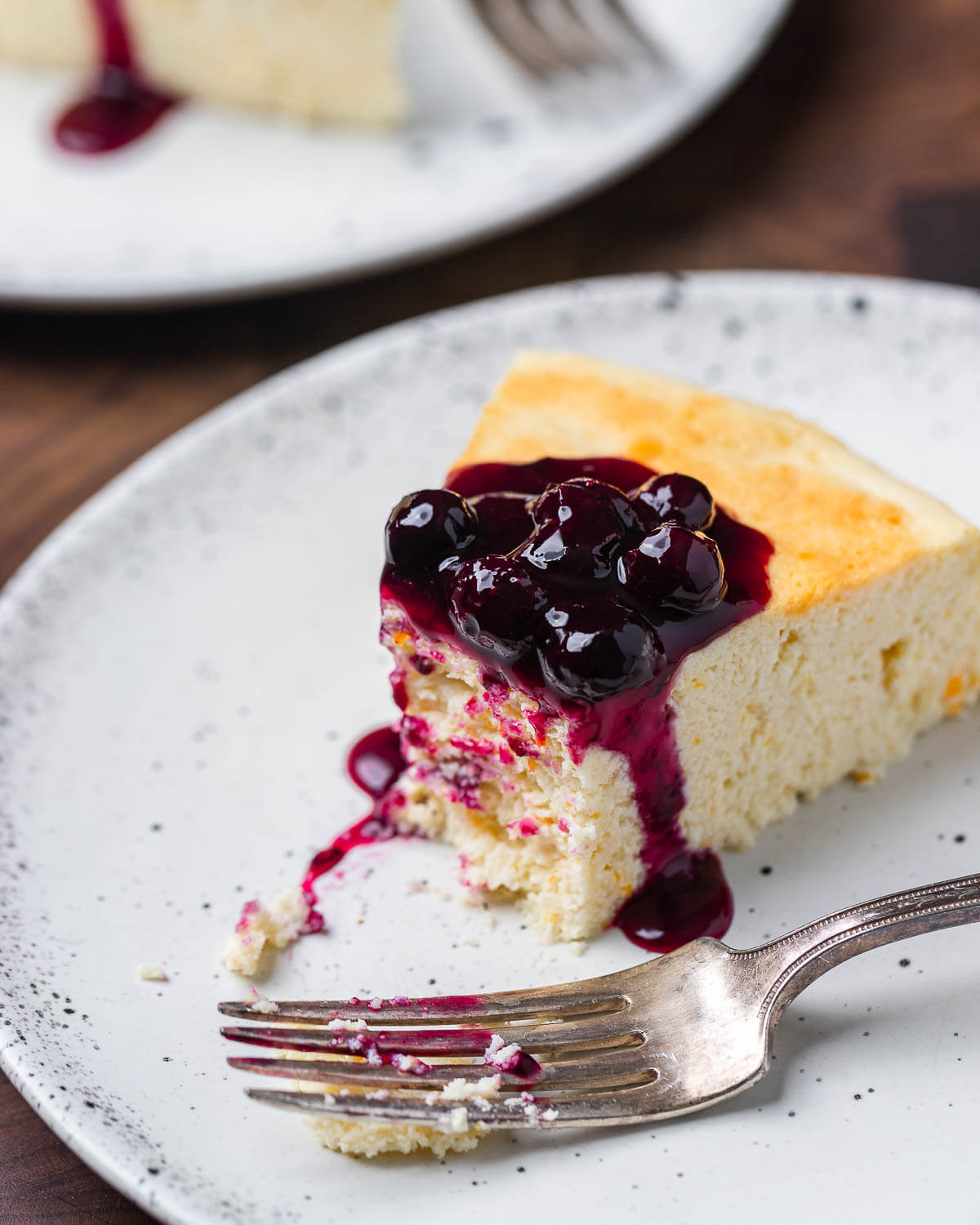
More sweet treats
Here are a few more of our favorite Italian-inspired desserts. We hope you love them as much as we do!
If you’ve enjoyed this Italian Cheesecake Recipe or any recipe on this site, give it a 5-star rating and tell us about it in the comments below.
We strive to satisfy a number of learning styles. If you are someone who prefers to learn by watching, you can find most of our recipes on YouTube and our Facebook Page.
For more never-before-seen FULL MEAL RECIPE VIDEOS, become a Patreon member today!
Italian Cheesecake
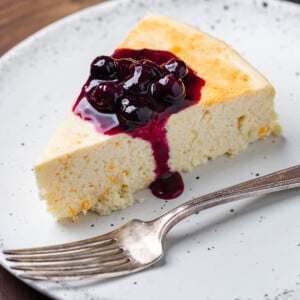
Equipment
Ingredients
For the cheesecake
- 2 pounds (908g) whole milk ricotta cheese strained (see notes below)
- 5 large egg yolks at room temperature
- 5 large egg whites at room temperature
- 1 cup (200g) granulated sugar divided (see below)
- 1/4 cup (35g) flour sifted, plus more for dusting
- 1 teaspoon vanilla extract
- 2 large navel oranges zested
- 2 tablespoons (28g) butter to coat the pan
For the blueberry sauce
- 10 ounces (290g) blueberries frozen blueberries
- 1/2 cup (120g) water
- 1/2 cup (100g) granulated sugar
- 1 1/2 tablespoons (14g) cornstarch dissolved in 1 1/2 tablespoons water
- 1 teaspoon vanilla
- 1 large lemon zested
Want To Save This Recipe?
Instructions
For the cheesecake
- Preheat your oven to 400f and using the butter, grease the bottom and sides of a 9" springform pan.
- Wrap the edges of the springform pan with two layers of foil and place in a roasting pan.
- In a large bowl, or bowl of a stand mixer, beat the ricotta until smooth, gradually adding 2/3 cup of the sugar and egg yolks, beating after each addition.
- Add the flour, orange zest, and vanilla.
- In a separate bowl, beat the egg whites for 30 seconds and gradually add the remaining 1/3 cup of sugar while beating on medium speed. Once all the sugar is added, beat on high speed until medium-soft peaks are formed.
- Using a spatula, fold the egg whites into the ricotta mixture taking care to not overmix, then add the mixture to the prepared springform pan. Add enough hot water to cover the bottom 1/2 of the pan for your water bath.
- Bake for 10 minutes at 400f then reduce the heat to 325 and bake for 45 minutes until golden on top and slightly jiggly in the center.
- Turn off the heat in the oven and allow the cheesecake to cool in the oven for 30 minutes with the door cracked. Remove from the oven and run a thin blade knife around the edge of the cake to make sure it's not sticking and allow the cake to come to room temperature. Then cover and move to the refrigerator for a minimum of 6 hours. Once chilled, remove the cake from the springform pan. Slice and serve with blueberry sauce on the side and enjoy!
For the blueberry sauce
- Place the blueberries, water, sugar, and vanilla in a small saucepan and cook over medium heat until the mixture comes to a slow boil.
- Stir in the cornstarch slurry and bring the mixture to a rolling boil, then turn the heat down and simmer for 1-2 minutes or until the mixture reaches your desired consistency.
- Remove from the heat and gently stir in the lemon zest taking care to not crush the blueberries.
- Serve over the cheesecake and enjoy!
Notes
- Draining the ricotta overnight through a cheesecloth or fine mesh sieve is required to ensure the cheesecake isn’t runny and bakes properly.
- Using the slow-cooking and cooling steps stated in the recipe is important to avoid cracking or deflating.
- The cheesecake can be stored in the refrigerator for up to 4 days.
- This recipe was written for a conventional oven. For convection ovens, reduce the temperature by 25 degrees and begin checking for doneness at the 75% mark.
Nutrition
Nutrition information is automatically calculated, so should only be used as an approximation.
Follow Me







So it’s 5 large eggs total, right? Separated and added in at different steps? Kind of unclear.
Hi Cece, that is correct. They’re broken out separately in the ingredients as “5 egg whites” and 5 egg yolks” to make it very clear that they are separate ingredients. If you look at the instruction steps it clearly says “egg yolks” in step 3, and “egg whites” in step 5.
How long will this stay good in the refrigerator?
Hi Tammy, this cheesecake can be stored in the fridge for up to 4 days.
Do I have to use a springform pan??? Can I use a regular round baking pan?
Hi Lo, we highly recommend using a springform pan for cheesecake and haven’t tested it in a different pan so can’t say what the results would be.
I was wondering if you could use parchment paper instead of grease and flour for the pan?
Hi Laura, for many recipes we do use parchment paper, but for this one I wouldn’t. Cheesecake is tempermental and we suggest following the recipe exactly.
Hi guys- this looks amazing. Thinking of making it for Christmas Day. How far in advance can this be made?
Hi Allison, you can make 1-2 days ahead and stored in the refrigerator. Hope you enjoy!
I would love to make this for Christmas. In the earlier directions you say a 9 inch spring pan and in the recipe below you say a 10 inch one. Is either one fine? Thanks so much. Your recipes are all fabulous!
Hi Laurie, sorry about that! We used a 9-inch pan but you could use either. With a 10-inch the cake won’t be as high.
can i use a 10 inch spring pan
Yes, the time may need adjusting though.
The BEST cheesecake I’ve ever tasted!
What can I use instead of flour (I don’t use cornstarch either) can it be made without it?
Hi Peggy, I haven’t tested the recipe with a substitute so I cannot say for sure, but a GF flour like Measure for Measure would probably be ok. If you try the recipe without flour, let us know how it turns out.
Hello Jim, I come from an Italian background and I find that your recipes are so familiar. I do have one question, my daughter is gluten free; do you think I can use gluten free flour in your Italian cheesecake recipe? I would love it make it for her. Thanks for your help.
Hi Mary Anne, So happy you’re enjoying the recipes. I haven’t tested the recipe with gluten-free flour but there is such a small amount of flour used I’d bet that subbing a GF flour like King Arthur Measure for Measure would be just fine. If you do give it a try, please let us know how it turns out.
It’s in the oven as I write this. Used Purecane sugar substitute (no off taste) and I’ve always put a pinch of nutmeg in my ricotta cheesecakes. I’ll freeze this for Christmas next week. Very easy recipe. Thank you (once again Jim!) for a great recipe.
Going to fix some of your seven fishes recipes for Christmas Eve. Buon Natale my friend!
Hi Nancy, thanks for the comment and hope you enjoy it once it’s done! Buon Natale to you as well!
This looks delicious! I have one question. In the ingredients, you mention 1/4 cup flour, plus more for dusting. I see where you add the flour to the cake batter, but I don’t see anything about dusting. Are you supposed to dust the inside of the cake pan after you butter it? Thanks in advance for your help!
Hi Mary-Ellen, after you butter/grease the sides and bottom of the pan, dust some flour onto the buttered surfaces and give the pan a shake to remove any excess flour. See the picture in step 3 for what the dusted pan will look like. Hope this helps!